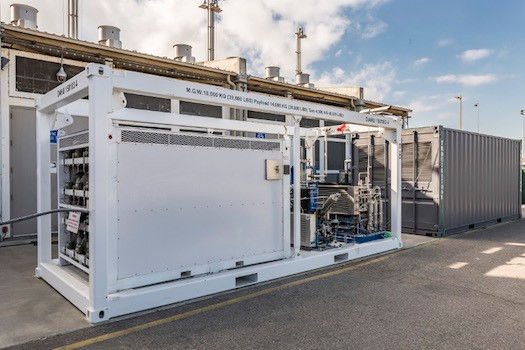Monday, 05/01/2026 | 18:38 GMT+7
Boeing has delivered a fuel cell energy storage system to the U.S. Navy for testing that will determine the system’s ability to support the energy needs of military and commercial customers.
According to Boeing, the system is the first of its kind to use a technology called a reversible solid oxide fuel cell to store energy from renewable resources, such as wind and solar, to produce zero-emissions electricity.
The system generates, compresses and stores hydrogen, Boeing said, noting that when the grid demands power, the system operates as a fuel cell, consuming the stored hydrogen to produce electricity. Because the system both stores energy and produce electricity in a single unit, the technology is “reversible,” Boeing said.

This first unit was commissioned on the Southern California Edison power grid at Boeing’s Huntington Beach, Calif., facility before being installed for further testing on the Navy’s microgrid at the Naval Facilities Engineering Command, Engineering and Expeditionary Warfare Center in Port Hueneme, Calif.
“This fuel cell solution is an exciting new technology providing our customers with a flexible, affordable and environmentally progressive option for energy storage and power generation,” Lance Towers, director, Advanced Technology Programs, Boeing, said in a Feb. 8 statement.
Boeing said the fuel cell product was developed using the company’s experience with energy systems for unmanned undersea vehicles and can be adapted and customized for a variety of defense and commercial applications.
Renewableenergyworld.com








 Webinar 2: “Financial Support for Energy Efficiency Enterprises – Opportunities and Challenges”
Webinar 2: “Financial Support for Energy Efficiency Enterprises – Opportunities and Challenges”
 Vietnamese enterprises achieve green growth and cut costs through energy efficiency
Vietnamese enterprises achieve green growth and cut costs through energy efficiency
 Capacity Building for Program Implementing Entity
Capacity Building for Program Implementing Entity
 Enhance Energy Efficiency Knowledge for Managers of Cement Industrial Enterprises
Enhance Energy Efficiency Knowledge for Managers of Cement Industrial Enterprises
 Capacity building for participating financial institutions in Ho Chi Minh City
Capacity building for participating financial institutions in Ho Chi Minh City
 Strengthening capacity for energy management officers of local government agencies
Strengthening capacity for energy management officers of local government agencies
 Steel Enterprises Saving Energy and Enhancing Competitiveness
Steel Enterprises Saving Energy and Enhancing Competitiveness